Key takeaways:
- Creative blocks arise from fear, self-doubt, and external pressures, and can signal a need for change or rest.
- Identifying triggers such as environment, emotions, expectations, and health is crucial for overcoming creative blocks.
- Engaging in mindfulness, light physical activities, and creative hobbies can help reset the mind and inspire new ideas.
- Creating a conducive workspace through thoughtful arrangement, sound, and lighting can significantly enhance creativity.
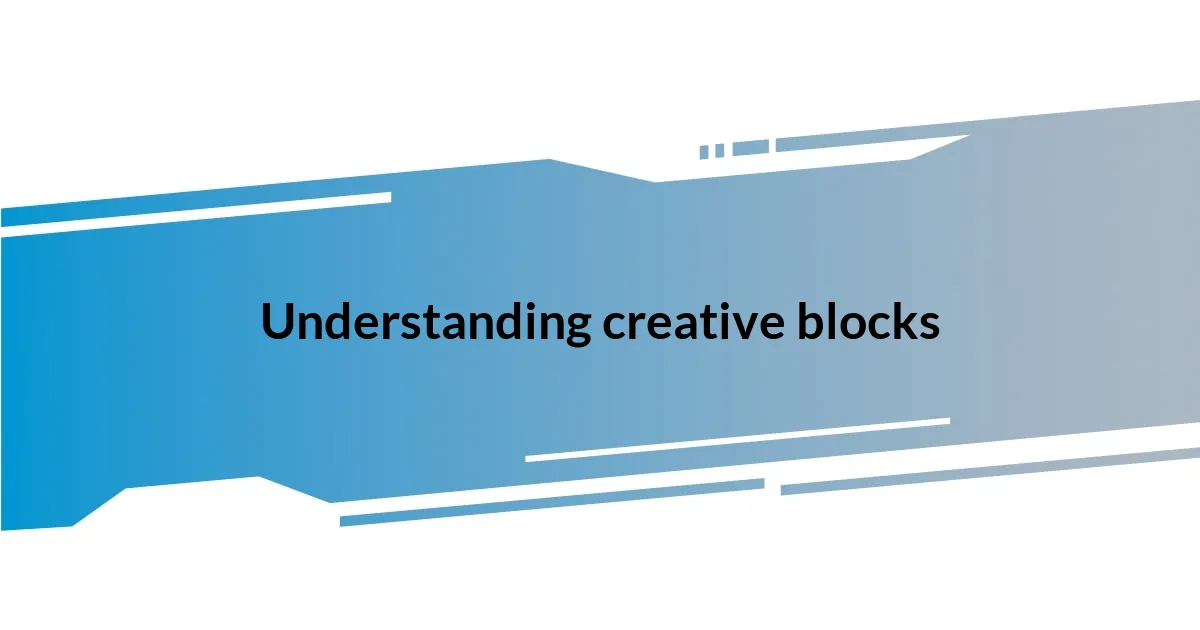
Understanding creative blocks
Creative blocks can feel like an insurmountable wall, an experience I’m sure many of you can relate to. I remember sitting for hours, staring blankly at a canvas, wondering why the ideas that once flowed so freely had suddenly vanished. It’s as if a part of my brain decided to take an unannounced vacation, leaving me frustrated and questioning my abilities.
These blocks often spring from a mix of fear, self-doubt, and external pressures. Have you ever felt the pressure to create something perfect that it stifled your creativity instead? I have, and it’s a reminder that our own expectations can sometimes become the very chains that hold us back from exploring our imagination. It’s crucial to understand that these feelings are common and can be embraced rather than shunned.
Digging deeper, I’ve found that a creative block might signal a need for change or rest. When I push through without understanding the root cause, I often come out feeling defeated. So, what if we viewed these blocks as opportunities for reflection instead? This mindset shift can unlock new paths and reinvigorate our creative process.
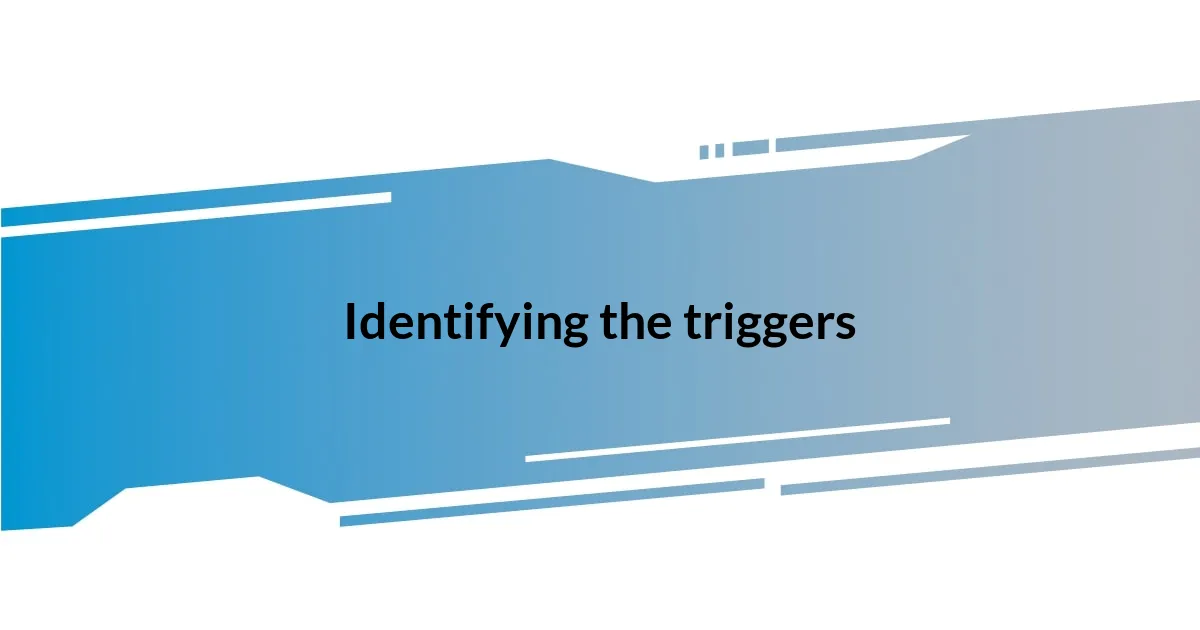
Identifying the triggers
Identifying the triggers behind creative blocks is an essential step in overcoming them. I remember a time when I found myself consistently struggling to write; it turned out that my environment was too noisy and chaotic, making it difficult for my mind to focus. By paying closer attention to my surroundings and emotional state, I began to notice patterns that pointed to the triggers behind my blocks.
To help identify your own triggers, consider these aspects:
– Environment: Is your workspace cluttered or distracting?
– Emotions: Are you feeling anxious, overwhelmed, or stagnant?
– Expectations: Are you putting too much pressure on yourself to succeed?
– Routine: Are you stuck in a monotonous creative routine that stifles inspiration?
– Health: Have you been getting enough rest or taking care of your mental well-being?
Recognizing these factors can lead to powerful insights that will guide you toward finding the solutions you need. The key is to remain curious about your creative patterns and be open to the idea that they may shift over time.
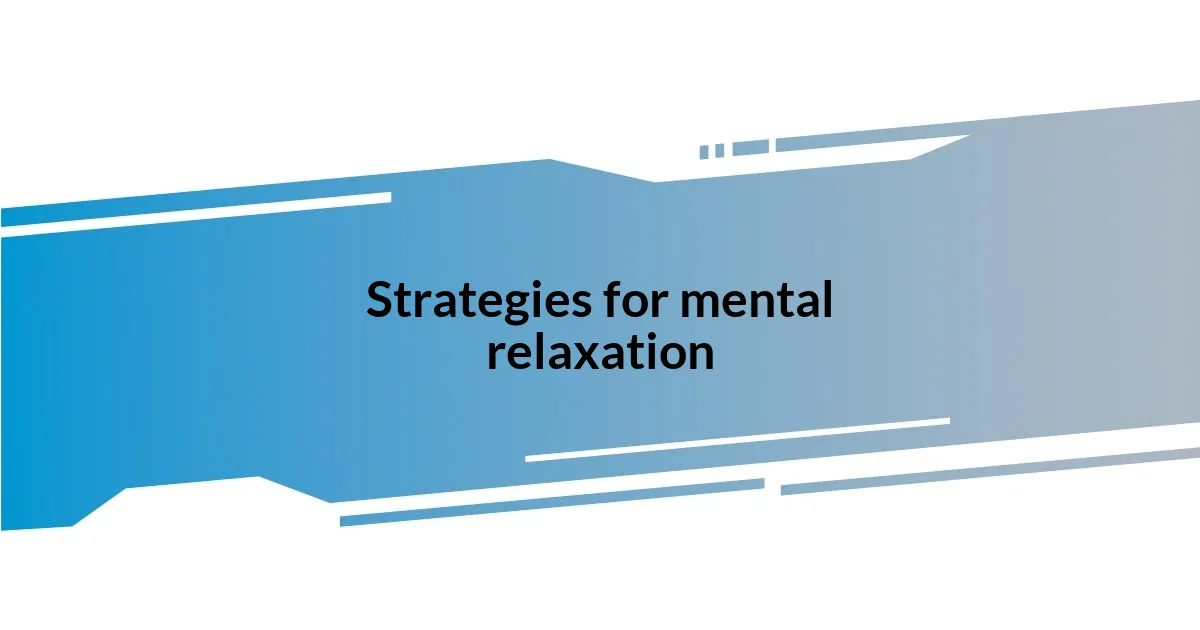
Strategies for mental relaxation
Mental relaxation strategies can truly transform the way we tackle creative blocks. One of my go-to techniques is mindfulness meditation. I recall a particularly stressful week when I felt overwhelmed by looming deadlines. Stepping back and dedicating just ten minutes to focused breathing helped clear the clutter in my mind, allowing me to return to my work with renewed energy and perspective. The beauty of mindfulness lies in its simplicity; it’s a gentle reminder to be present instead of lost in the chaos of thoughts.
Another effective approach is engaging in light physical activity, like a stroll in the park. I often find that moving my body helps free my mind, drawing inspiration from nature’s beauty around me. On days when I feel particularly stuck, I make it a point to get outside, breathe in the fresh air, and feel the sun on my skin. This connection to my surroundings helps me ground my thoughts and can lead to unexpected bursts of creativity. Movement doesn’t just relax my mind; it sparks new ideas.
Lastly, I have embraced the power of creative hobbies unrelated to my main work. Painting or playing an instrument provides a delightful distraction from my usual projects, letting my mind wander freely. I remember picking up my guitar one evening after a long day; within minutes, I was lost in melodies that had nothing to do with my current work. This playful engagement offers a mental reset, allowing me to return with fresh ideas and enthusiasm.
| Strategy | Description |
|---|---|
| Mindfulness Meditation | A practice to focus on breathing and being present, helping clear mental clutter. |
| Light Physical Activity | Engaging in activities like walking to rejuvenate the mind and spark creativity. |
| Creative Hobbies | Pursuing unrelated creative activities as a way to reset and inspire new thoughts. |
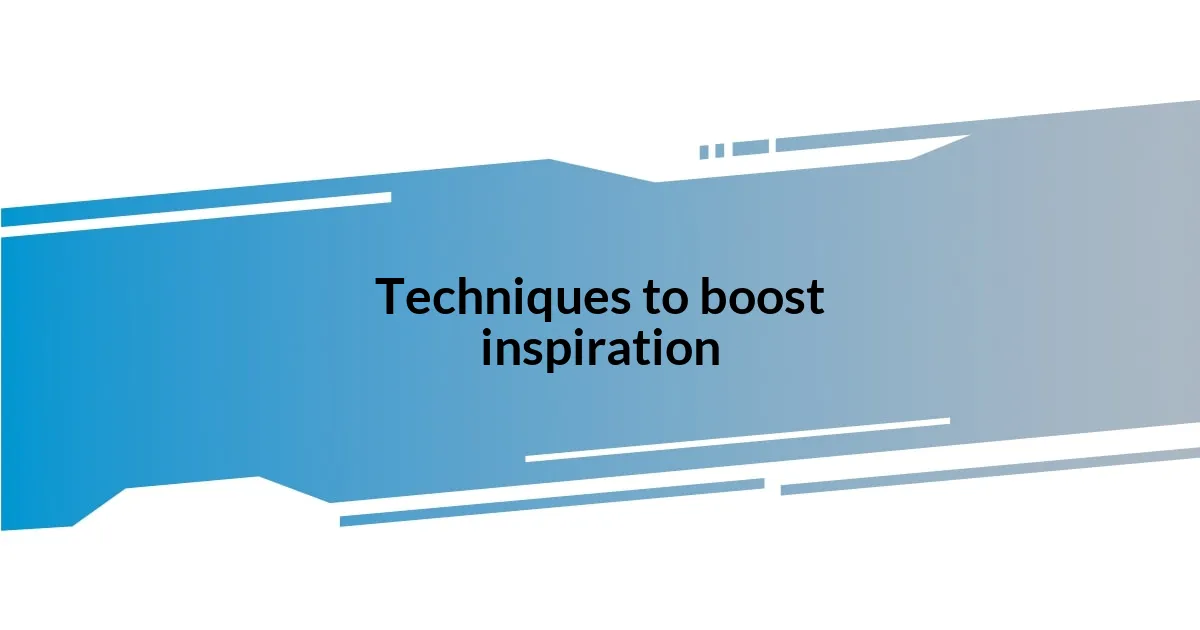
Techniques to boost inspiration
One technique that has significantly boosted my inspiration is changing my scenery. I remember a time when I was stuck on a project, feeling utterly uninspired as I sat at my same old desk. On a whim, I decided to take my work to a local café instead. The fresh environment, mixed with the sound of coffee cups clinking and soft chatter around me, sparked ideas I hadn’t even considered. Isn’t it interesting how a simple shift in location can break the monotony and ignite creativity?
Engaging in creative prompts can also be a wonderful way to stimulate inspiration. I often set aside time to explore writing challenges or even doodle as a way to free my mind. One morning, I found a prompt asking for a short story about a lost object. As I scribbled away, weaving in a narrative about a forgotten toy, I was pleasantly surprised at how quickly fresh ideas began flowing. It made me think—why not embrace the playful side of creativity more often?
Additionally, I find journaling to be incredibly beneficial. Writing down my thoughts or feelings allows me to unload mental baggage that often clouds my creativity. Sometimes, when I feel stuck, I let my pen flow without judgment for a few minutes. It’s amazing how unlocking my internal dialogue can reveal unexpected insights. Have you ever tried it? I’m telling you, those moments of honest expression can lead to lightbulb moments that are just waiting to be discovered!
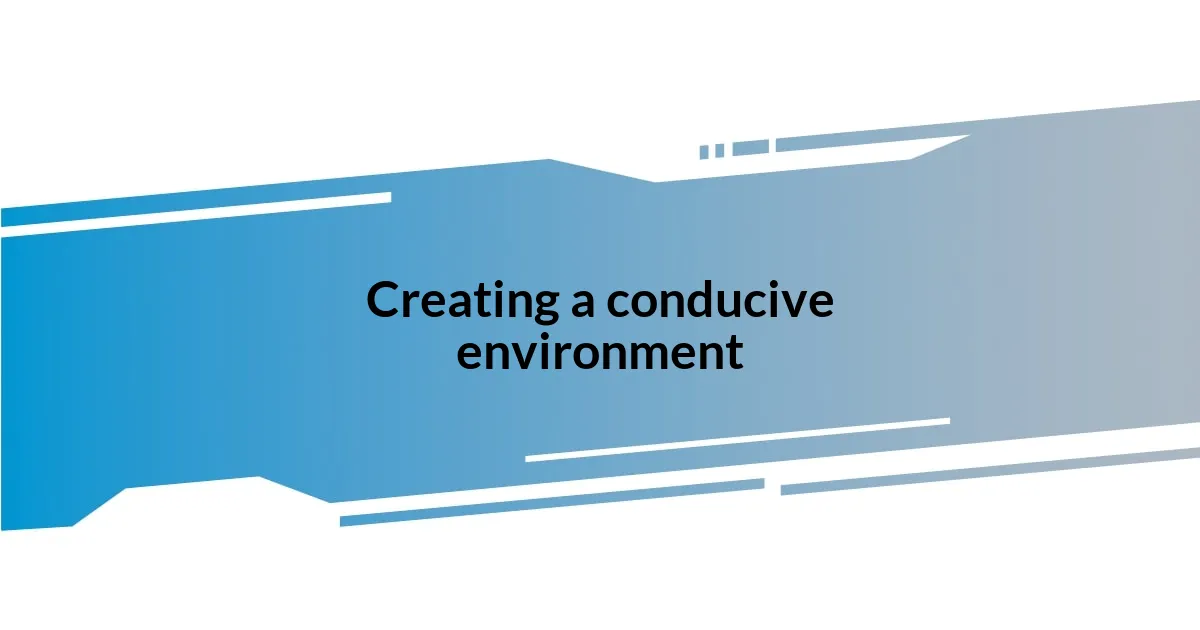
Creating a conducive environment
Creating a conducive environment for creativity is a core aspect that I often overlook. I always feel amazed at how much my surroundings influence my thought process. For instance, I once transformed my workspace by adding a few plants and colorful art pieces. Surprisingly, the greenery not only breathed life into the room but also lifted my spirit, making brainstorming sessions feel more vibrant and energetic.
In addition to physical elements, I’ve begun to appreciate the importance of sound in my creative space. There were days when I would struggle to concentrate with noise swirling around me. So, I decided to experiment with music, creating playlists tailored for different moods. One day, I listened to some instrumental jazz while working on a design project, and it was as if the rhythm guided my thinking. Have you ever noticed how the right soundtrack can open your mind to new patterns? It’s quite powerful.
Lighting is another critical factor that often shapes my creative flow. I used to stay in bright, harsh spaces, but once I introduced softer, warmer lights, everything changed. I remember an evening spent writing under the dim glow of fairy lights; it felt cozy and intimate, allowing the words to spill onto the page with ease. Isn’t it fascinating how something as simple as adjusting the lights can alter your entire mindset? By experimenting with my environment, I’ve learned that a conducive space is not just about aesthetics; it’s about creating a sanctuary that truly nurtures creativity.
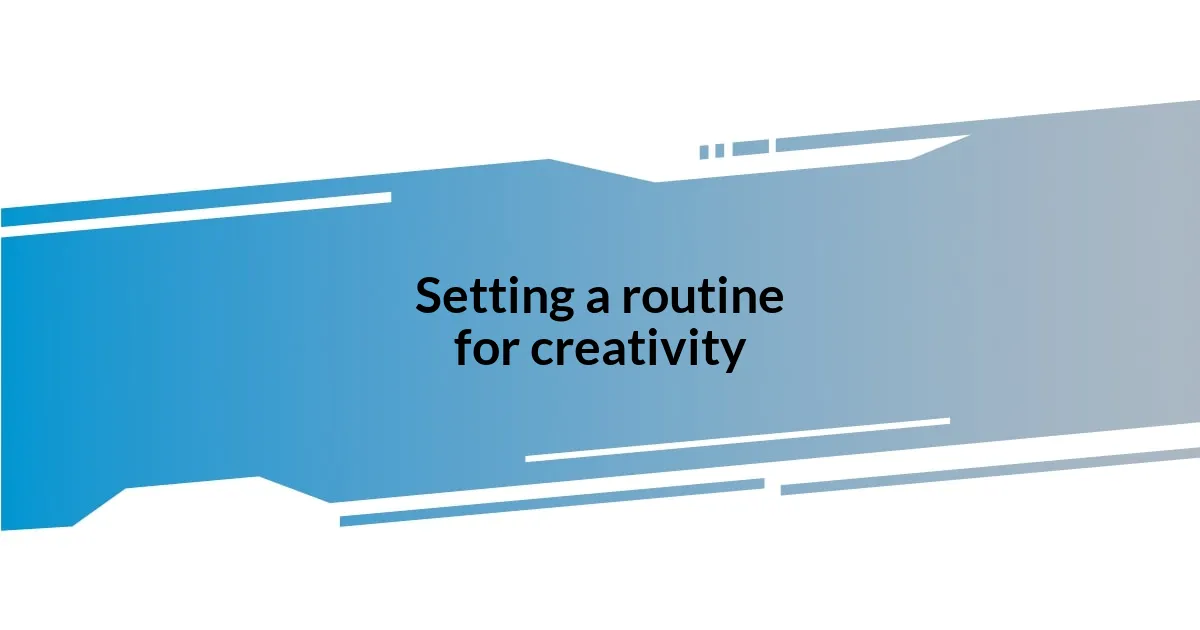
Setting a routine for creativity
Setting a routine for creativity has been a game-changer for me. I used to dive into projects whenever inspiration struck, only to find that many days passed without any progress. Realizing this inconsistency, I decided to carve out specific times in my day dedicated to creative work. Simply having those blocks of time marked on my calendar felt like an invitation to show up for myself and my ideas. Have you ever noticed how a little structure can turn your chaos into clarity?
What’s even more interesting is introducing rituals to my routine. For instance, I always start my creative sessions with a cup of herbal tea. This small act signals my brain that it’s time to shift gears from daily distractions to focused creativity. I’ve found that the warmth of the tea and the moment of reflection it provides gives my mind space to wander. Doesn’t it make sense that when we create a welcoming atmosphere for ourselves, our best ideas can flourish?
With time, I’ve also learned to respect my natural rhythms. I noticed I felt most creative in the early morning, so I started waking up just a bit earlier to write or sketch. Embracing that quiet time before the world wakes up has turned into a treasured part of my day. It’s almost magical how fewer interruptions allow thoughts to flow freely. How about you? Have you identified your own peak creative hours? It’s incredible how aligning our routines with our natural energy can lead to breakthroughs I once thought elusive.
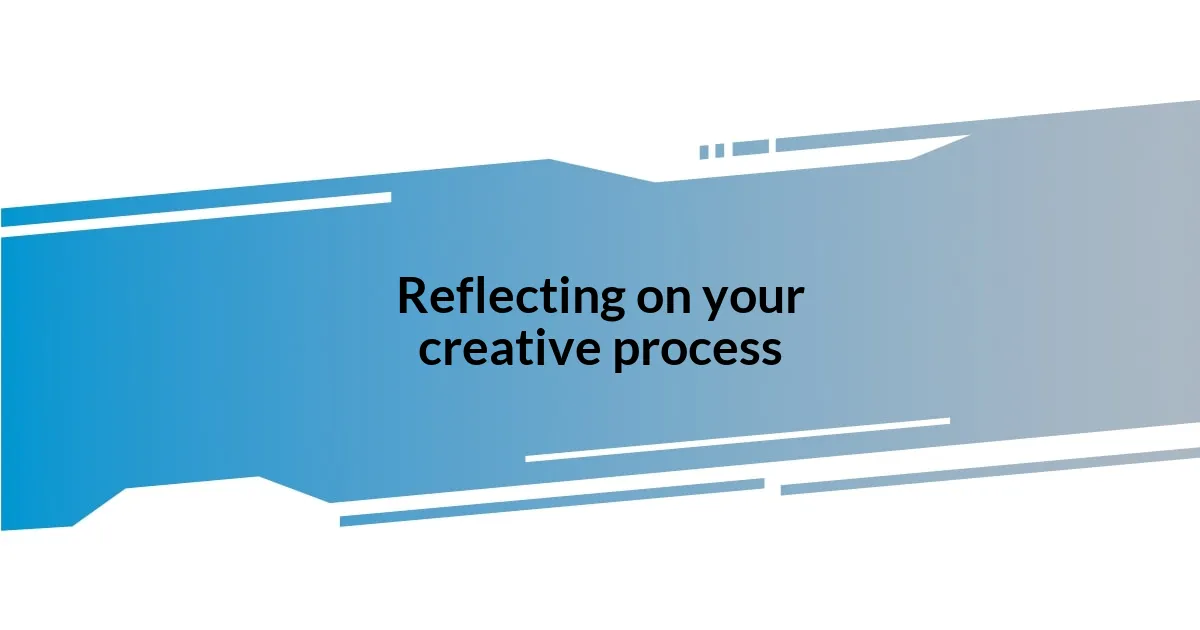
Reflecting on your creative process
Reflecting on my creative process often reveals patterns I hadn’t noticed before. For instance, I realized that my best ideas usually surface shortly after I’ve allowed myself to step away from my work. I remember a time when I was struggling with a writing piece, so I took a long walk in the park. Out of nowhere, the words flowed into my mind like a waterfall upon my return. Isn’t it interesting how sometimes the best solutions come when you’re not even trying?
Journaling has become a vital part of my reflection. After each project, I take a moment to jot down what worked and what didn’t. I still recall the first time I did this; I was astonished at how many insights I uncovered about my strengths and weaknesses. It’s like holding up a mirror to my creative self. Have you ever considered how this practice could help you understand your own process better?
Additionally, I’ve learned to embrace the ebbs and flows of creativity. There was a period when I felt guilty for not being productive enough, but reflecting on past experiences showed me that creativity isn’t constant. I now celebrate my bursts of inspiration, as well as the quieter times, understanding that both are essential for growth. What if, instead of viewing those lulls as setbacks, we saw them as moments for reflection and recharge? This shift has been liberating for me, allowing me to trust the journey rather than fixate on the output.